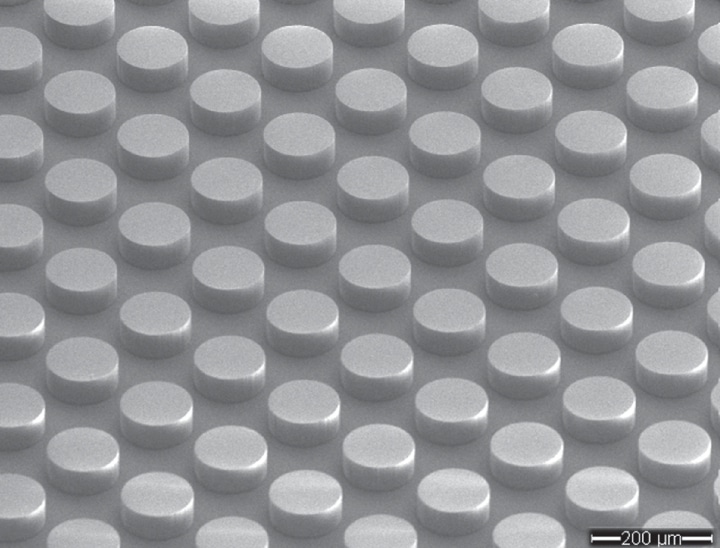Jan 30 2017
 Each cylinder of this new non-metal metamaterial is made of boron-doped silicon and precisely tailored to absorb electromagnetic waves. (Credit: Duke's Pratt School of Engineering)
Each cylinder of this new non-metal metamaterial is made of boron-doped silicon and precisely tailored to absorb electromagnetic waves. (Credit: Duke's Pratt School of Engineering)
Electrical engineers from Duke University have developed the first electromagnetic metamaterial in the world without any metal. The ability of the device to absorb electromagnetic energy without heating up has direct applications in sensing, imaging, and lighting.
Metamaterials are synthetic materials made up of several individual, engineered attributes that together create properties that are not present in nature. Visualize an electromagnetic wave passing through a flat surface composed of several thousand miniature electrical cells. If researchers can tweak each cell to control the wave in a specific way, they can dictate precisely how the wave acts as a whole.
Researchers have had to typically use electrically conducting metals to control electromagnetic waves. However, that technique comes with a fundamental problem of metals - when the electrical conductivity is higher, the material also conducts heat in a better manner. This restricts their usefulness in temperature-based applications.
In a recent paper, electrical engineers at Duke University show the first fully dielectric (non-metal) electromagnetic metamaterial. Its surface is dimpled with cylinders like the face of a Lego brick that is engineered to absorb terahertz waves. While this specific frequency range sits between microwaves and infrared waves, the technique has to be applicable for nearly any frequency of the electromagnetic spectrum.
The results were published online on January 9 in the Optics Express journal.
People have created these types of devices before, but previous attempts with dielectrics have always been paired with at least some metal. We still need to optimize the technology, but the path forward to several applications is much easier than with metal-based approaches.
Willie Padilla, Professor of Electrical and Computer Engineering, Duke University
Padilla and his colleagues developed their metamaterial using a non-metal called boron-doped silicon. With computer simulations, they calculated the way terahertz waves would interact with cylinders of different widths and heights.
After that, the researchers manufactured a prototype made up of several of these enhanced cylinders arranged in rows on a flat surface. Physical tests revealed that the new "metasurface" was capable of absorbing 97.5% of the energy generated by waves at 1.011 terahertz.
Efficient absorption of energy from electromagnetic waves is a key property for a number of applications. For instance, thermal imaging devices can function in the terahertz range, but since they have previously included at least a small amount of metal, obtaining sharp images has been difficult.
Heat propagates fast in metals, which is problematic for thermal imagers. There are tricks to isolate the metal during fabrication, but that becomes cumbersome and costly.
Xinyu Liu, Doctoral Student, Duke University
Efficient lighting is another potential application for the new technology. Incandescent light bulbs produce light but also create a major amount of wasted heat. They must function at high temperatures to create light - a lot higher than the melting point of most metals.
We can produce a dielectric metasurface designed to emit light, without producing waste heat. Although we've already been able to do this with metal-based metamaterials, you need to operate at high temperature for the whole thing to work. Dielectric materials have melting points much higher than metals, and we're now quickly trying to move this technology into the infrared to demonstrate a lighting system.
Willie Padilla, Professor of Electrical and Computer Engineering, Duke University
The Department of Energy supported this research.